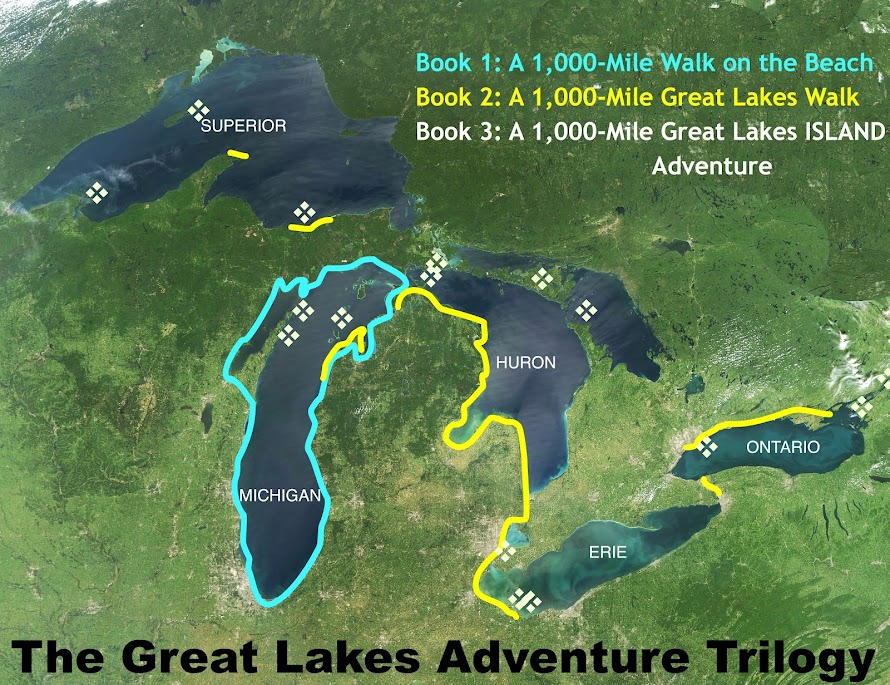
Dead birds on the Lake Trek
While on my walk around Lake Michigan, I passed many dead and dying birds. Most were victims of avian botulism. It was heartbreaking to know that there wasn't anything I could do for the ones that were partially paralyzed and helpless on the shore. They would either recover or die depending on how much of the toxin they had ingested.
What causes it?
The bacteria that produces the botulism toxin (Chlostridium botulinum) is naturally present in the environment. It the same bacteria that produces toxins that can kill people if not destroyed when canning food. It is an anaerobic bacteria which means it thrives in an oxygen-poor environment.
If the bacteria has always been around, why are more and more birds dying each year? And why has the end of 2010 had a particularly high mortality rate?
Changes in the lake
The lakes have changed with the introduction of the invasive mussels (both zebra and quagga mussels). You've seen the changes if you've walked the lakeshore. The striped shells of the dead zebra mussels are strewn in the sand along Michigan's western coast. And if you've spent any amount of time on the lake you've probably seen algae blooms that seem to grow larger each year.
Scientists haven't fully figured out all the feedback loops that allow increasingly more devastation to our bird population, but it goes something like this:
- Algae blooms are encouraged by run-off from farms and discharges of untreated sewage from treatment plants overwhelmed by heavy rain. And the blooms increase when the water temperatures increase.
- Algae blooms decay and use up oxygen in the process leading to anaerobic zones.
- Anaerobic bacteria like Chlostridium botulinum proliferate in these 'dead zones' and release toxins into the water.
- Toxins are filtered out of the water and concentrated in the mussels.
- Mussels are eaten directly by birds or by fish that are then eaten by birds.
- Birds are paralyzed by ingested toxins. The effects are dose-related and it takes very little to kill a bird.
This year on some stretches of shoreline, up to 50 dead birds have washed up per mile. Several bloggers covering the Leelanau Peninsula have reported on the increased mortality (check out Books In Northport Blog).
This year has had a confluence of several factors leading to this increase in mortality. It was a warm year, so the lake temps were up significantly. It was also an especially rainy year and that led to massive discharges of untreated or partially-treated sewage from major cities around the lake. Heavy rain can also carry run-off from farms which contain animal waste and fertilizer. All of this fertilizer and organic material feeds the algae.
What can be done?
It seems that the more that is learned about avian botulism, the more perplexed scientists and naturalists are at the best way to attempt to solve the problem. They admit that they may not know all the variables contributing to the problem. And a factor like increasing lake temps during an especially warm year are outside our immediate control.
It would seem logical to control the variables within our immediate control. Cities like Grand Rapids have updated their sewers to partition sewage from storm drain collection. This city has reduced their sewage discharge into the Grand River to almost zero while cities like Milwaukee, Chicago and Gary continue to divert billions (that's billions with a 'b') of gallons of storm water mixed with untreated or partially-treated sewage into Lake Michigan annually.
Green zones along the lakeshore are an important buffer for the lake and wetlands can serve to filter water before it enters the lake.
If you own property on the lake, don't fertilize, or check with the DNR for the type they advise using.
If you see dead birds on the lakeshore, don't handle them with bare hands or let dogs munch on them. The toxins persist after the bird dies and can be harmful to any other vertebrate coming in contact with it. Report number and type of dead birds to the DNR and make a note of any banding numbers on birds. If possible, bury carcasses or tie up in garbage bags and discard to minimize the chances of another animal being poisoned.

Loreen, thanks for the very informative update on this issue. I've sent your link to a couple of friends and asked them to pass it along, too.
ReplyDeleteGlad it was helpful, Pamela. I don't usually write such long posts, but I wanted to fully explore this problem.
ReplyDeleteI'm getting increasingly concerned about Lake Michigan. There's only so much abuse it can continue to bounce back from, and these mussels are attacking the ecosystem from several angles.